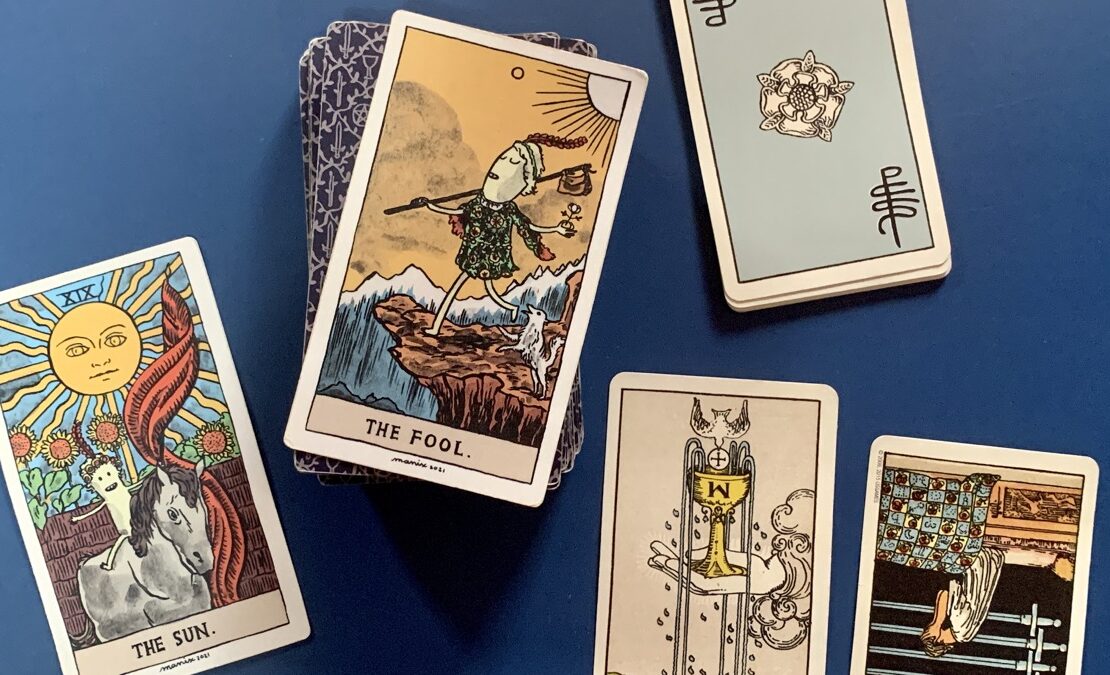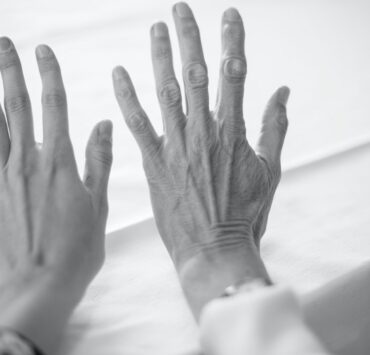If this post finds you, this message is for you.
That line, and dozens of other variations of it, may have already made its way into your social media feeds at one point or another. Now before you scroll away, hear me out: I think tarot could be for you. Yes, whether you believe in the “magic” of it or not.
If we look at it sans the mystical lens, tarot can be a wonderful tool for self-discovery and personal growth. The practice is also a good way to care for our mental and emotional states.
But first thing’s first: What is tarot?
Tarot draws from a long history: Records of cards akin to the tarot we are familiar with today date back to the 1400s, and were originally used as playing cards. Many other theories on the origins of tarot exist, both from eastern and western traditions.
While some records do mention tarot as mere playing cards, others also cite their usage as tools for divination, hence the long-standing notion that equates tarot with the occult.
One of the most popular tarot decks now is the Rider-Waite-Smith (RWS) tarot. It is iconic in that it is rich in imagery, lodged in scenes that could each tell a story. The 22 trump cards, collectively called the Major Arcana, basically depict the Fool’s Journey, or one’s journey through life, and named presumably after the tarot’s first card, “The Fool.” (In literature and myths, it’s like the Hero’s Journey, as popularized by Joseph Campbell, who in turn was inspired by psychologist Carl Jung’s analytical psychology!) Meanwhile the 56 pip cards, called the Minor Arcana, depict various more mundane life experiences. The cards draw from various cultural and religious influences, which may also aid in or enrich the user’s interpretation.
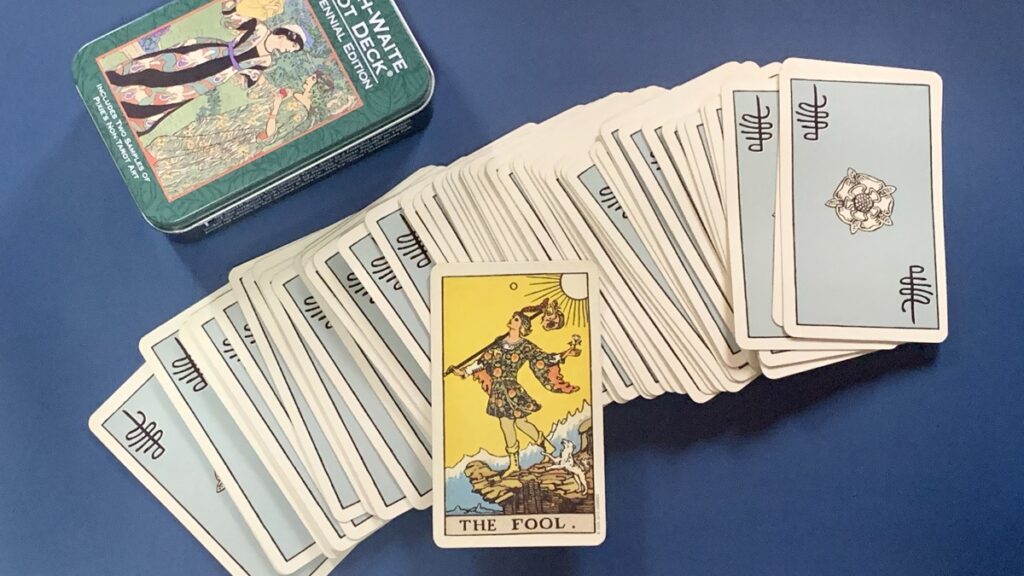
Tarot and psychology
From its roots as a card game and a magic tool however, tarot in the 21st century is now also slowly being recognized for its potential to aid in psychological practice.
Part of it may be because of the psychological archetypes that are depicted on the cards. But even various other aspects of tarot practice, including tapping into the unconscious, or even the collective unconscious, as well as noting synchronicities, find some basis in the concepts developed by Jung.
Many have also begun to study it as a tool for self-exploration or even as ways to bridge people towards more established therapy solutions (e.g. journaling, meditation, etc.).
[Tarot is] super effective as a tool for self-reflection because it encompasses the universal human experience—all packed in its 78 cards.Phoebe Casin, Tarot by Folià
“Holistic Tarot” author Benebell Wen echoes this. She writes, “Tarot [is] a holistic tool that can help us mine our own unconscious to find answers… The cards do not tell us what to do. Rather, they help us think about our problems from a different perspective and, like a diagnostics tool for decision-making, help chart a roadmap for the solution.”
Charting our thoughts
Using the tarot is a great way to check in with ourselves—to see what we think may be going well or not so well in our current situation, or to bring to the surface thoughts or feelings we’ve been avoiding. (Because self-care isn’t always fun! As writer, tarot reader, and Practical Magic creator Chinggay Labrador puts it, “Caring for yourself… means doing tough work, too.”)
Sometimes the cards reveal areas of your life that need extra care and compassion.
Belle Mapa, writer, mental health advocate
While the past two years have exposed me to a variety of tarot readers online, many still on the mystical, divinatory side (uh, thanks, I guess, #tarotok), there is immense relief in discovering that there are also practitioners that advocate for the use of tarot for self-discovery and self-care.
Freelance writer and tarot reader Phoebe Casin notes: “[Tarot is] super effective as a tool for self-reflection because it encompasses the universal human experience—all packed in its 78 cards.” Phoebe started reading tarot for herself in 2020, and has since opened her own tarot reading services for clients, called Tarot by Folià.
I admittedly started my tarot journey asking readers about the all-too-expected, yet universal subject of love, but it has since evolved to examining my thought patterns. I impulsively bought my first deck when comic artist Manix Abrera released his “Samantala, Ikaw at Ang Hiwaga” tarot deck. The deck is based on the classic RWS tarot, but in Abrera’s signature art style. As a fan of his comics, I just knew I had to get my hands on them, even if I didn’t know how to read the cards. I thought I’d figure that out when the cards get here.
That soon led to reading the tarot almost daily to get a better grasp of each card’s meanings. I would ask (myself? The cards? The universe? God?) more general, day-to-day things. “What aspect needs my attention?” One day, I’d be feeling agitated or discontented, and bam, I’d get Temperance. Keep calm, be patient. Got it. Next day it could be, ack, the IX of Swords. Okay, that’s right, I’m really overthinking things, that’s why I’m upset.
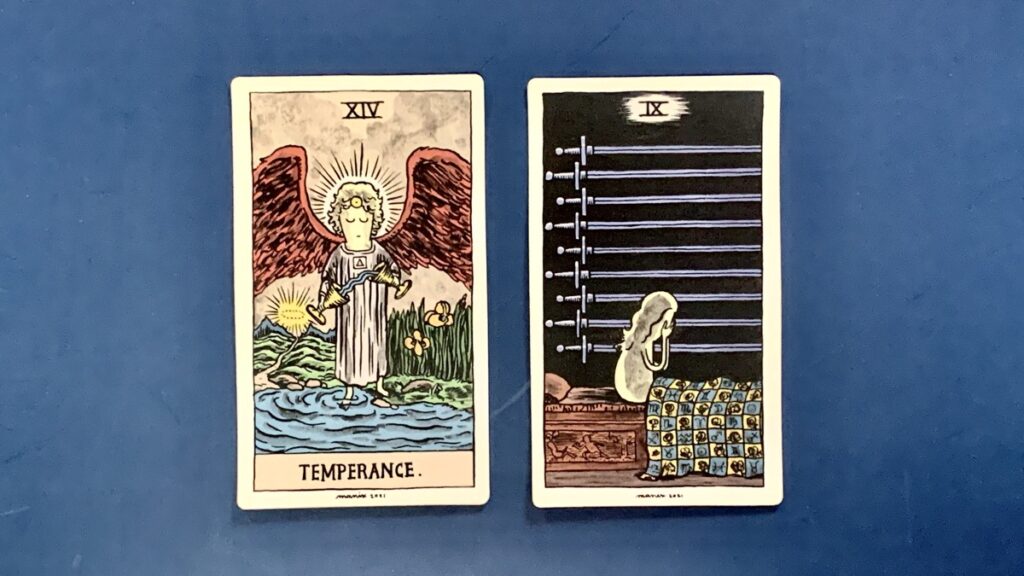
In short, regularly pulling cards has allowed me to identify patterns in my thoughts and emotions from day to day. The imagery and its associated meanings—or sometimes even the intuitive feelings I get from just looking at the card’s artwork—also prompt me to flesh out and understand my experiences more.
Phoebe shares the same sentiment. “More than just a deck of cards with pretty imagery, the tarot, for me, is actually a mirror of the self. Doing daily card pulls and reading for myself regularly has allowed me to see aspects of myself (the subconscious) that, perhaps, I was too ‘scared’ to see even at face value,” she says.
“Daily tarot pulls meant I was also following a routine, and a comforting one at that. I was diagnosed with depression and anxiety in 2018 so having a somewhat ‘predictable’ routine during the pandemic has helped me cope,” she adds.
Meanwhile, for writer and mental health advocate Belle Mapa, tarot serves as “a grounding exercise.” Belle has been reading tarot since 2017.
“Tarot has definitely helped me with my self-image, decision-making, and conflict resolution. Honestly, I use my tarot cards to call me out on my topak. I know I’m not infallible,” she says. “They help me take a step back, analyze a situation, hold space with my feelings, and really unpack what’s going on.”
Aside from helping with self-awareness and processing situations, tarot has also helped others with achieving closure and acceptance. For “Claire” (who requested anonymity), tarot helped her be more open to accepting things out of her control. She had just started reading tarot two months ago.
“I was diagnosed with bipolarity and anxiety order. For those of us who have a mental health condition, what’s generally easy to do becomes really, really difficult and frustrating… What used to get me upset was that I couldn’t make sense of it. So I would ask a lot of questions (like why couldn’t I do this task when it used to be very easy?), and that generated more strain and negativity.
“Tarot gives me temporary answers. Or closure for the day. Especially when the spread makes a lot of sense! It teaches me to avoid blaming my mental health, but to learn and tune into different aspects of mental states… It gives me a vocabulary and teaches me to distinguish what needs nourishing,” she says.
Another beautiful thing about the practice of reading tarot for yourself is how it can also coincide with or supplement other self-care practices, like meditation, or journaling.
“It’s nice to use them as self-care journaling prompts. All the more with oracle cards! It encourages self-expression. Sometimes the cards reveal areas of your life that need extra care and compassion. One of my decks is sassy and rude and will real-talk me with feasible solutions, and I journal those sessions down to see what actions I can take now or in the near future,” Belle, a self-professed journaling junkie, shares.
Embarking on the Fool’s Journey
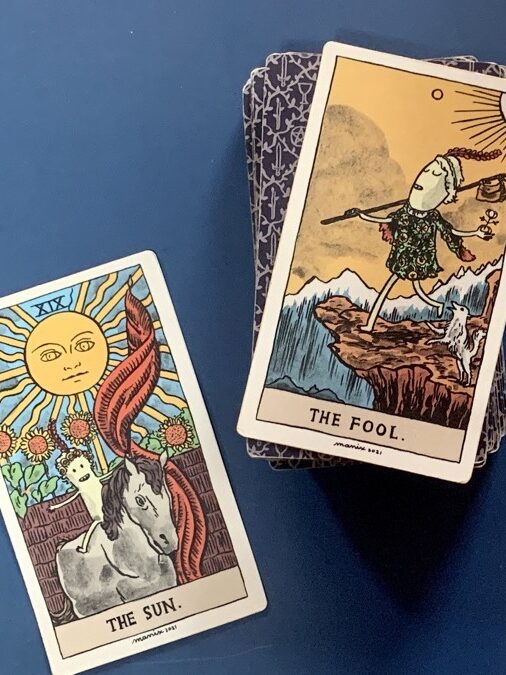
What’s fun about using the tarot for self-reflection is that you’re not just mulling things over in your head. It can get pretty messy in there, and sometimes we think we’d need a “second opinion.” Phoebe likens the tarot to a companion you can have a conversation with at a moment’s notice.
Our thoughts and emotions can sometimes turn into an overwhelming, tangled mess. Tarot is one way to focus one one “thread”; it is like a friend that holds on to the string so we can see where the knots are, and we can pull and unravel it.
[Tarot] teaches me to avoid blaming my mental health, but to learn and tune into different aspects of mental states… It gives me a vocabulary and teaches me to distinguish what needs nourishing.
At the end of the day, tarot will not tell us what to do. It just gives us a nudge, a subtle point towards the possibilities or limitations of a certain direction. Ultimately, all actions and decisions are ours. The tarot is, after all, just images on paper.
Chinggay, in a blog post, puts it rather bluntly and clearly: “Tarot is magical because it helps you connect to your soul, not because some goddess is housed between the paper fibers of your cards.” Take it from the tarot deck creator, folks.
If you do decide to start using tarot for your mental and emotional well-being, here are some tips:
Use a deck you like. While the RWS deck is the most widely-used deck today, there is a wide selection of decks available. They come in all sorts of shapes, sizes, and designs, so feel free to pick whichever you’re drawn to. After all, you’ll be the one using this frequently, so best to choose one you’ll be happy with.
Take notes. We all know the science of note-taking and how it helps in encoding information in our memory. As you learn the tarot and start pulling cards for yourself, take notes on the cards you pulled, what meanings and insights you got from them, even what you asked or what you were thinking or feeling when you made the draw. That way, you can also track your progress both as a reader, and in terms of your mental and emotional states.
Be open. Sometimes, we’ll get cards that we don’t particularly like. But again, self-care is not always comfortable, and embarking on the road towards self-improvement means we have to face and acknowledge aspects of ourselves that aren’t that pretty. “Go into it with an open mind and heart, with intention but without expectation. But also don’t take the reading or yourself too seriously. Have fun lang. It’s not the end of the world if you get The Tower,” Belle says.
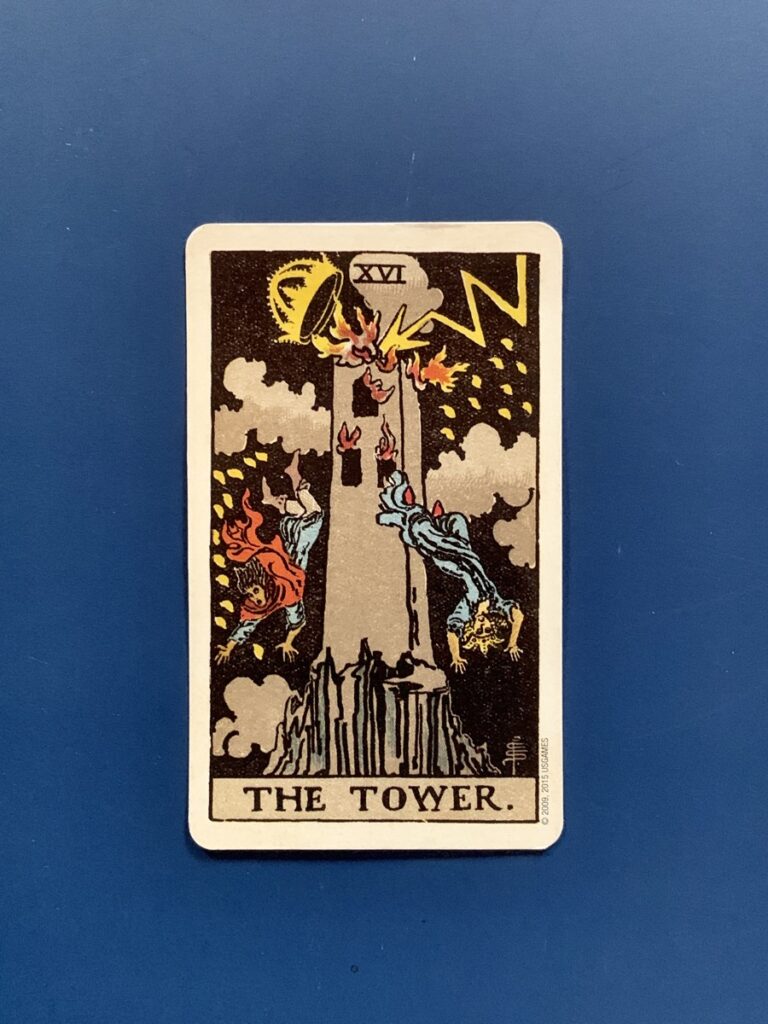
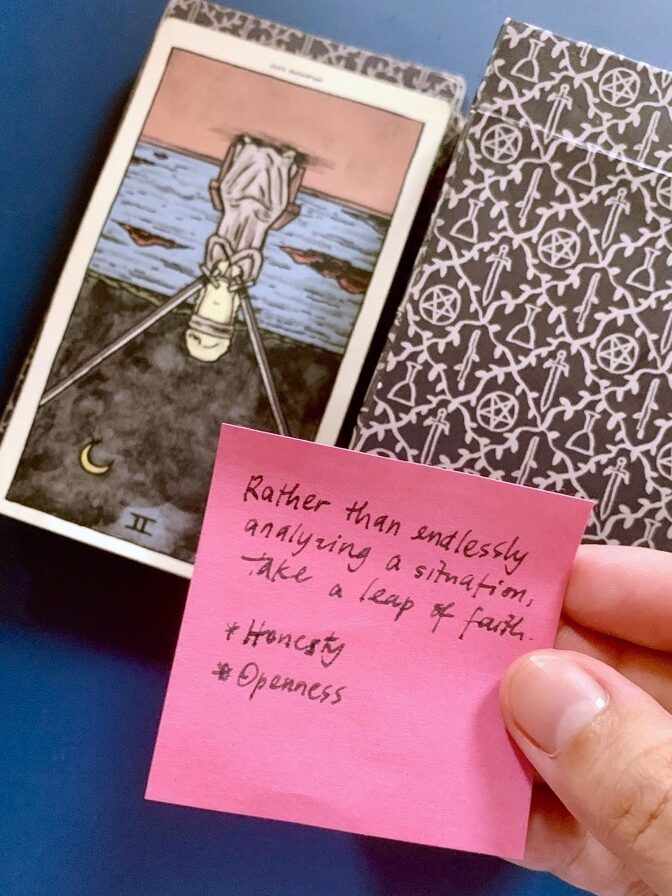
Continue to seek professional medical help. Even if tarot has proven to be a useful tool in managing one’s mental well-being, “remember that it’s not AND WILL NEVER BE a replacement for a medical diagnosis, psycho- or talk therapy, or medicine,” Phoebe says.
Belle adds, “Tarot is not a substitute for therapy and medication. It’s nice to understand your thoughts/feelings/subconscious/higher self. But if you need help, get help. More ‘professional’ tarot readers are popping up, too. I know people who have a suki tarot reader, and they treat it like therapy. It’s not.”

